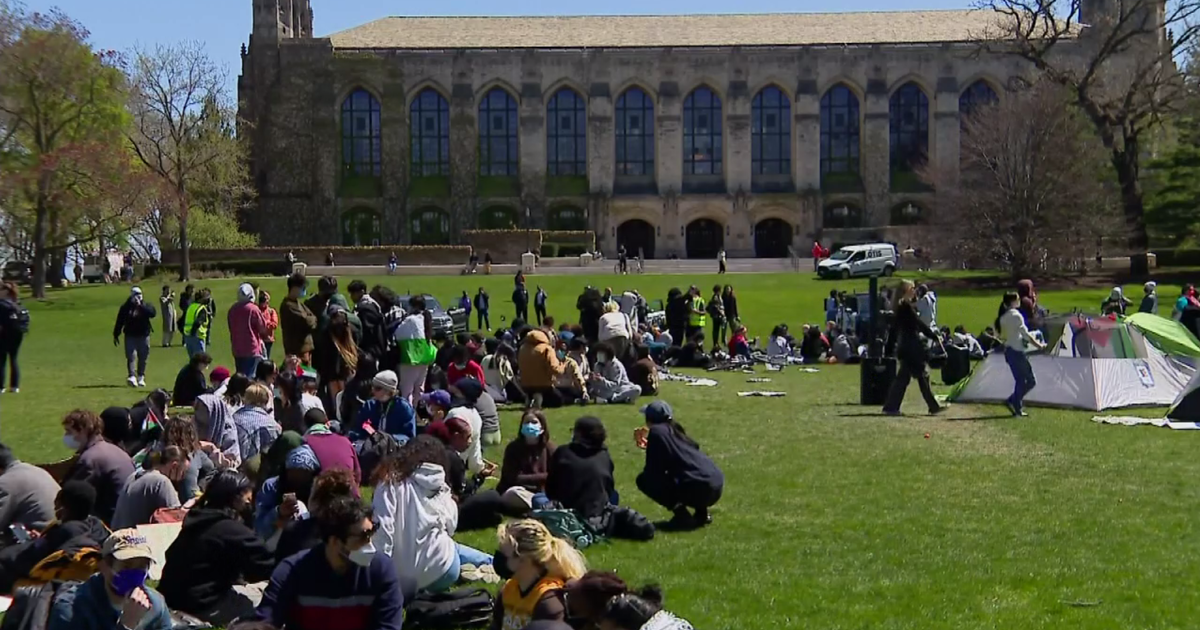Alderwoman: 'Nude beach' sign in Rogers Park was not authentic; it has since come down
CHICAGO (CBS) -- Despite what a sign that might be mistaken for an official Chicago Park District notice may say, you had best keep your clothes on if you're visiting Loyola Beach in Rogers Park.
Ald. Maria Hadden (49th) posted a photo on social media of a sign reading, "Nude beach past this sign," at Loyola Beach – which stretches along the Lake Michigan shoreline from Touhy Avenue to just north of Pratt Boulevard.
A photo of the sign taken by Mark McCormick, and posted to the Rogers Park News Facebook group, went on to circulate on social media Monday morning. McCormick reported spotting the sign just north of the pier at the end of Pratt Boulevard.
Some people who left comments on the Facebook post appeared to think a nude beach really had been established in Rogers Park, while others questioned whether the photo had been edited with PhotoShop. McCormick responded in the comments that he had stood right in front of the sign and taken the photo.
WBBM Newsradio reported there were two signs, but photos have not surfaced of a second one.
Ald. Hadden reported her office had been notified that someone had installed the "cheeky sign" on a metal pole at the beach. She emphasized that it is not really an official Chicago Park District sign – and her office has reported it to the Park District so it can be taken down.
Ald. Hadden emphasized on social media "at least some clothing is required at all of our beaches."
The Park District itself also left a comment on the Rogers Park News Facebook post: "This is not an official Chicago Park District sign. The Chicago Park District is working on removing all unauthorized signage. Please note: Unauthorized use of the Chicago Park Chicago Park District's Aquatics seal is strictly prohibited."
The Park District later left a comment saying the sign had been taken down.
The alderwoman did not immediately return a call for further comment.
In her Facebook post on the subject, Ald. Hadden noted that in 1932, then-Ald. George Williston (49th) had introduced a resolution to allow for nude sunbathing at the same beach. Hadden attached a Chicago Tribune clip from the time.
"The proposal was hedged about, however, with restrictions designed to mollify sniffish ladies and gentlemen who have sniffed at the carryings on of nudist cults in Germany and elsewhere in Europe," the Tribune report said.
Williston's 1932 resolution was to authorize a Lakeview man, Dr. Arne L. Suominen – who had been "designated the spokesman for a large group of citizens interested in sunbathing" – to build an enclosure for that purpose on the beach in Rogers Park, the Tribune report said. The enclosure was to be of such a height that it would not be seen from nearby buildings or other vantage points, and was to be divided into separate men's and women's spaces, the Tribune reported.
According to the book "Naked: A Cultural History of American Nudism" by Brian Hoffman, physical culture promoter Bernarr Macfadden talked up the idea of the nude sunbathing area at Rogers Park Beach – forecasting that 20,000 sunbathers would visit the enclosure, and the number would later grow to 200,000.
A 1990 Chicago Reader article by Ron Dorfman noted that Suominen was a "prominent Chicago naturopath." As quoted by the Tribune by way of Dorfman's article, Suominen touted nude sunbathing over the use of bathing suits – in part on the grounds that a Swiss expert had proclaimed "an unbalanced exposure makes an individual irritable instead of affording relaxation."
If the ordinance calling for the nude beach enclosure were to be approved, the Tribune reported, aldermen said they would "ask that the building commissioner subject Mr. Suominen's enclosure to a special inspection for knotholes."
Dorfman's 1990 article said the proposal for the nude beach enclosure did not pass.
(N)eighbors, including the students at a nearby Catholic high school, protested and the ordinance failed to pass the City Council," Dorfman wrote.
The Women's Christian Temperance Union – headquartered a stone's throw to the north in Evanston – also lobbied hard against the proposed nude sunbathing enclosure, according to Hoffman's book.
But Suominen kept trying, Dorfman wrote, presenting a petition with 10,000 signatures to the Lincoln Park Board calling for a nude sunbathing enclosure on the beach – suggesting a nine-foot stockade fence lined with sheet metal to keep it out of sight. The proposal before the Park Board died in committee, Dorfman wrote.
Dorfman's 1990 article went on to document other calls for nude beaches or recreation spaces over the decades. He wrote that Park Board President James H. Gately summarily rejected a demand for a public space for nude recognition in 1949.
And even in later eras perhaps thought of as more liberated, Dorfman wrote, people who dared to go nude on Chicago beaches did not get away with it.
"A classified ad placed in the Reader in 1975 by someone who called himself Keith Speludnik brought to the advertised 'nude-in' at Oak Street Beach perhaps a dozen men, one woman, and two children who ditched their swimsuits offshore, cheered on by a thousand or more spectators," Dorfman wrote. "The cops arrested three young men who walked back onto the beach without their trunks."
Nearly half a century later – and more than 90 years after those "sniffish" neighbors prevailed over Dr. Suominen in Rogers Park – nudity on Chicago beaches remains prohibited. And for that matter, Chicago beaches close for the season after Monday anyway.




